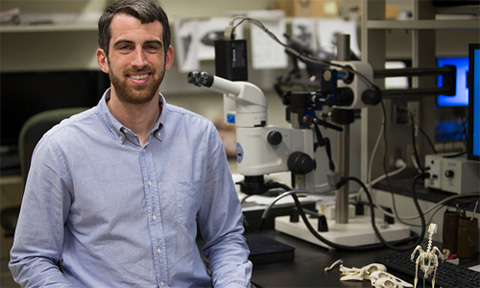By Angelita Faller
Forty-nine million years ago, a freshwater bird known as Limnofregata azygosternon lived in the ancient lakes of what is now Wyoming. Leaving behind only a few skeletons, it is hard to imagine how this extinct bird once looked and lived.
Thanks to the research of Ryan Felice, a doctoral student in Biological Sciences at Ohio University, we can now envision the tailbones and feathers of this ancient bird, revealing important information about how Limnofregata flew, hunted and lived.
Limnofregata’s modern-day relatives, frigatebirds, have a deeply forked tail fan that gives them great agility and maneuverability while flying great distances into the ocean to hunt. In fact, frigatebirds are famous for stealing the prey out of the claws of other birds.
Scientists initially thought Limnofregata had a much more tame hunting life than its modern relatives. Its skeletal remains indicated it was not nearly as agile or suited for open ocean life as frigatebirds.
After discovering that Limnofregata’s reconstructed tailbone looks remarkably similar to its modern relatives, Felice thinks that Limnofregata lived much differently than scientists originally suspected.
“It seems like this ancient bird had started to evolve some of the specialized features observed in its modern relatives and may have had some ecological similarities to them. Its modern relatives are highly aerial predators and live in open-ocean environments, so Limnofregata may have behaved in this way as well,” he said.
Felice hopes that his research will be used to create visual representations of what other fossilized birds looked like and answer questions about how the birds lived.
“It’s very easy, when you are dealing with fossil animals, to just think of them as a pile of bones all the time. In life they had flesh and skin and feathers, and just trying to really understand the diversity of form in extinct ecosystems is interesting to me. There are tons of birds out there that we can apply that to,” he said.
In addition to solving the mysteries of Limnofregata, Felice’s research also revealed an evolutionary difference in the tailbones of birds with different hunting strategies. Birds that hunt in the air have a shorter, more bent pygostyle (the last vertebrate in a bird’s tailbone), he found, while those that feed underwater have a longer and straighter pygostyle.
Memories of a Childhood Trip to the Museum, and Jurassic Park
Felice’s love for examining fossils came from fondly remembered childhood trips to the American Museum of Natural History in New York City and a popular 1993 blockbuster.
“Like any kid in the early 1990s, I had seen Jurassic Park and the dinosaurs in the museum, so I wanted to be a paleontologist, and I never grew out of that phase,” he said.
Felice received a B.S. in ecology and evolutionary biology from Tulane University in 2009. While attending a conference, a friend introduced Felice to his soon-to-be academic adviser, Patrick O’Connor, a professor of anatomy at the Heritage College of Osteopathic Medicine. The pair had similar research interests, so Felice decided to attend Ohio University.
One of Felice’s major assets as a researcher is his willingness to collaborate with others, a trait that is very important in scientific research, O’Connor says. Felice often gives mini-workshops on research methods to his fellow graduate students.
The student also has been successful at securing funding for his research. Felice received a 2013 Student Enhancement Award from the Office of the Vice President for Research and Creative Activity and a graduate research fellowship from the Ohio Center for Ecology and Evolutionary Studies.
This funding allowed him to take some time off from his teaching duties to spend the fall 2013 semester traveling the country to measure skeletons of 50 different bird species at nine museums.
His has published two articles in the scientific journal PLOS ONE and has been featured in Audubon Magazine.
After Felice graduates in May, he will continue his research on the morphology of tailbones as a post-doctoral research or assistant professor.
Felice’s dissertation research has focused on understanding variations in the tailbones and feathers of birds, but now he wants to discover why birds have pygostyles, when their long-extinct ancestors, dinosaurs and other living relatives of dinosaurs, such as crocodiles, do not have this tailbone.




















Comments